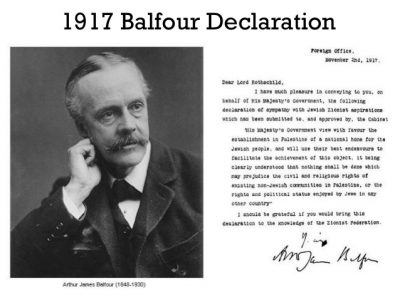Palestine and the Balfour Declaration, Explained in Eight Memes

ongoing to this day.
[Watch Al Jazeera English video: 100 Years On: The Balfour Declaration explained]
The language used in the document that facilitated this disaster, the Balfour Declaration, is devious and self-serving, the kind of language that can be found in every document to which the Palestinian people have been subjected — and supposedly drafted by an impartial power — only to be revealed later as a Zionist instrument.
For example, the final clause of the Balfour Declaration includes the so-called “safeguard” for Palestinian Arabs. It reads:
“… it being clearly understood that nothing shall be done which may prejudice the civil and religious rights of existing non-Jewish communities in Palestine or the rights and political status enjoyed by the Jews in any other country.”The craftily phrased reference to “non-Jewish communities” is especially galling and fraudulent, as it was written to conceal the true ratio between Palestinian Arabs (91% at the time) and Jews — “an Arab population with a dash of Jew. Half of the Jews were recent arrivals” as it has been described, and thereby to make easier the suppression of the indigenous population.
Notice also in this infamous clause that “civil and religious rights” qualify “non-Jewish communities in Palestine” and “political status” is added only about Jewish rights — a political bias against Palestinian Arabs and for Jewish colonial supremacy in Palestine that is flagrantly evident to this day, not only in the UK, but also in the US.
Here are eight memes that explain the terrible triple bind Palestinians continue to suffer under the Balfour Declaration:
Meme One: The Balfour Declaration taught the Zionist movement that a Jewish state in Palestine relying on a superpower patron will have impunity from censure.
[Read The Americanization of Zionism, 1897–1948 by Naomi Wiener Cohen on Google Books here.]
Meme Two: Without American Jewish-Zionists such as Louis Brandeis, the Balfour Declaration would likely never have been issued.
[Read Who wrote the Balfour Declaration and why: The World War I Connection]

(L-R) Chaim Weizmann, future president of Israel, with Louis Brandeis, US Supreme Court Justice, in Palestine, 1919. The two were instrumental in obtaining the Balfour Declaration, a British document that many feel was a critical step in the establishment of Israel. Zionists’ promise that they would get the U.S. to join Britain in “the Great War” was the enticement.
Meme Three: Zionism’s Jewish-state mission had its own independent sources of finance & support, besides those offered by Britain’s Balfour Declaration. [See Zionism: World Zionist Organization (WZO)
Meme Four: Double Whammy! Unlike most other colonized peoples, Palestinians had to fight against not only the foreign colonial Jewish entity in their midst but also the Balfour Declaration. [See Rashid Khalidi: Balfour Declaration Must be Matched by National Home for Palestinians]
Meme Five: The legality accorded to the Balfour Declaration by the League of Nations also explains the challenges facing Palestinians trying to retain their ancestral homeland. [Read The Real Story of How Israel Was Created]
Meme Six: The Balfour Declaration must now be matched by a national home for Palestinians. [Read Understanding the Jewish National Home]
Meme Seven: The UK should condition bilateral ties with Israel, including trade, on respect for international law and human rights. [Read A century after Balfour, the UK should face uncomfortable home truths]
Meme Eight: “The Balfour declaration sparked a national tragedy for the Palestinian people — WITH BDS, WE ARE FIGHTING BACK.” – Omar Barghouti
The bind in which Palestinians find themselves because of the Balfour Declaration is a triple whammy. They continue to fight not only the well-funded Jewish Zionist colonization of Palestine but also the Zionist-propelled machinations of imperial powers, both in the waning British and rising American empires. And as the Declaration was accepted by the League of Nations, Palestinians also must face the “legality” of a corrupt international order [Read Why is it so difficult to reform the United Nations Security Council?].
Rima Najjar is a Palestinian whose father’s side of the family comes from the forcibly depopulated village of Lifta on the western outskirts of Jerusalem. She is an activist, researcher and retired professor of English literature, Al-Quds University, occupied West Bank.
The original source of this article is Global Research
Copyright © Rima Najjar, Global Research, 2017
Comment on Global Research Articles on our Facebook page
Become a Member of Global Research

No comments:
Post a Comment